
An ironclad is a steam-propelled warship protected by iron or steel armor plates, constructed from 1859 to the early 1890s. The ironclad was developed as a result of the vulnerability of wooden warships to explosive or incendiary shells. The first ironclad battleship, Gloire, was launched by the French Navy in November 1859 - narrowly pre-empting the British Royal Navy.

HMS Dreadnought was an ironclad turret ship built for the Royal Navy during the 1870s. Construction was halted less than a year after it began and she was redesigned to improve her stability and buoyancy. Upon completion in 1879, the ship was placed in reserve until she was commissioned in 1884 for service with the Mediterranean Fleet. Upon her return 10 years later, she became a coast guard ship in Ireland for two years. The ship then became a depot ship in 1897 before she was reclassified as a second-class battleship in 1900. Dreadnought participated in the annual fleet manoeuvres for the next two years before she became a training ship in 1902. The ship was taken out of service three years later and sold for scrap in 1908.

Pre-dreadnought battleships were sea-going battleships built between the mid- to late- 1880s and 1905, before the launch of HMS Dreadnought in 1906. The pre-dreadnought ships replaced the ironclad battleships of the 1870s and 1880s. Built from steel, protected by case-hardened steel armour, and powered by coal-fired triple-expansion steam engines, pre-dreadnought battleships carried a main battery of very heavy guns in fully-enclosed rotating turrets supported by one or more secondary batteries of lighter weapons.

The Royal Navy's Victoria class of the 1880s was the first class of ironclad warship which used triple expansion steam engines, previous classes having used compound engines.
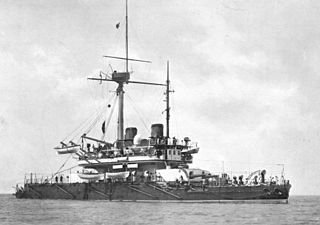
HMS Thunderer was one of two Devastation-class ironclad turret ships built for the Royal Navy in the 1870s. She suffered two serious accidents before the decade was out and gained a reputation as an unlucky ship for several years afterward. The ship was assigned to the Mediterranean Fleet in 1878 and was reduced to reserve in 1881 before being recommissioned in 1885. Thunderer returned home in 1887 and was again placed in reserve. She rejoined the Mediterranean Fleet in 1891, but was forced to return to the UK by boiler problems the following year. The ship became a coast guard ship in Wales in 1895 and was again placed in reserve in 1900. Thunderer was taken out of service in 1907 and sold for scrap in 1909.
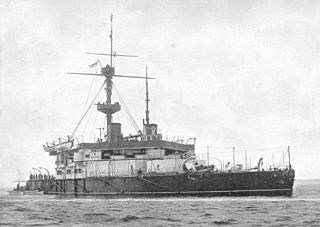
HMS Trafalgar was one of two Trafalgar-class battleships commissioned in 1890 and 1891, the other being HMS Nile. The ship was designed as an improved version of existing battleships with greater displacement and a thicker armoured belt amidships. Trafalgar saw active service as a battleship from 1890 to 1897 and from 1909 to 1911 when she was sold. Between these two periods as a combatant, Trafalgar served as a guardship and as a drill ship.

The two Trafalgar-class battleships of the British Royal Navy were late-nineteenth-century ironclad warships. Both were named after naval battles won by the British during the Napoleonic wars under the command of Admiral Nelson. The two ships were named HMS Nile and HMS Trafalgar.

The eighth HMS Shannon was the first British armoured cruiser. She was the last Royal Navy ironclad to be built which had a propeller that could be hoisted out of the water to reduce drag when she was under sail, and the first to have an armoured deck.

A fast battleship was a battleship which emphasised speed without – in concept – undue compromise of either armor or armament. Most of the early World War I-era dreadnought battleships were typically built with low design speeds, so the term "fast battleship" is applied to a design which is considerably faster. The extra speed of a fast battleship was normally required to allow the vessel to carry out additional roles besides taking part in the line of battle, such as escorting aircraft carriers.
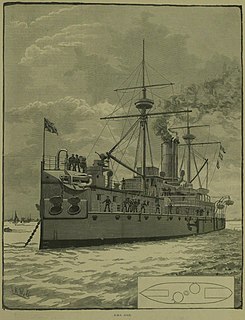
HMS Ajax was the name ship of her class of ironclad battleships built for the Royal Navy during the 1870s. Completed in 1883, she was immediately placed in reserve until 1885 when the ship was commissioned for the first time. Later that year, Ajax was assigned as a coast guard ship in Scotland and remained there for the next six years. She was reduced to reserve again in 1891 and was taken out of service a decade later. The ship was sold for scrap in 1904 and subsequently broken up.
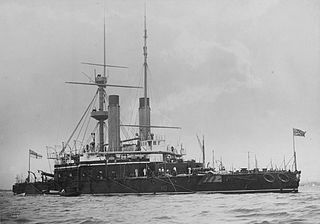
HMS Nile was one of two Trafalgar-class ironclad battleships built for the Royal Navy during the 1880s. Late deliveries of her main guns delayed her commissioning until 1891 and she spent most of the decade with the Mediterranean Fleet. Nile returned home in 1898 and became the coast guard ship at Devonport for five years before she was placed in reserve in 1903. The ship was sold for scrap in 1912 and broken up at Swansea, Wales.

The Eclipse-class cruisers were a class of nine second-class protected cruisers constructed for the Royal Navy in the mid-1890s.

HMS Adventure was the name ship of her class of two scout cruisers built for the Royal Navy during the first decade of the 20th century. For two years after being completed in 1905, the ship was in reserve. She was commissioned in mid-1907 as a flotilla leader in the Home Fleet. When the First World War began in August 1914, she was assigned to patrol the English Channel. In mid-1915 Adventure was transferred to Irish waters to serve as the flagship there. In early 1918, the ship escorted convoys to Gibraltar before being transferred to the Mediterranean at the end of the war. She returned home in mid-1919 and was paid off. Adventure was sold for scrap in early 1920.
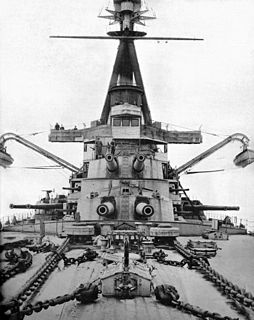
Superfiring armament is a naval military building technique in which two turrets are located in a line, one behind the other, with the second turret located above ("super") the one in front so that the second turret can fire over the first. This configuration meant that both forward or aft turrets could fire at any target within their sector, even when the target was in the same vertical plane as the turrets.

The Gloire-class ironclads were a group of three wooden-hulled armored frigates built for the French Navy in the late 1850s and early 1860s. Gloire, the lead ship of the class, was the first ocean-going ironclad warship to be built by any country. The ships of the Gloire class were classified as armoured frigates because they only had a single gun deck and their traditional disposition of guns arrayed along the length of the hull also meant that they were broadside ironclads.

Durandal was the name ship of her class of four destroyers built for the French Navy in the late 1890s.

Framée was the name ship of her class of four destroyers built for the French Navy around the beginning of the 20th century.
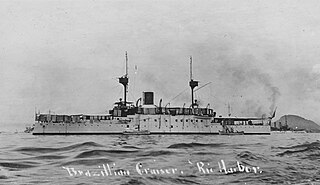
The Deodoro class were two French-designed and built coastal defense battleships built for the Brazilian Navy in the late 1890s. Upon their completion, Scientific American called them small vessels of a type "built only for second-rate naval powers," but also noted that it was a "wonder ... so much armor and armament could be carried" on a ship of its size. They served the Brazilian Navy as its only modern armored warships until the arrival of two dreadnoughts in 1910.
HMS Vesuvius was an experimental torpedo-armed warship of the British Royal Navy. Built by Pembroke Dockyard in 1873–1874, she was the first purpose-designed torpedo vessel built for the Royal Navy. Vesuvius was intended for night attacks against enemy harbours, and was armed with a single tube for Whitehead torpedoes in her bow. She was used for experimental and training purposes, and was not disposed of until 1923.

















